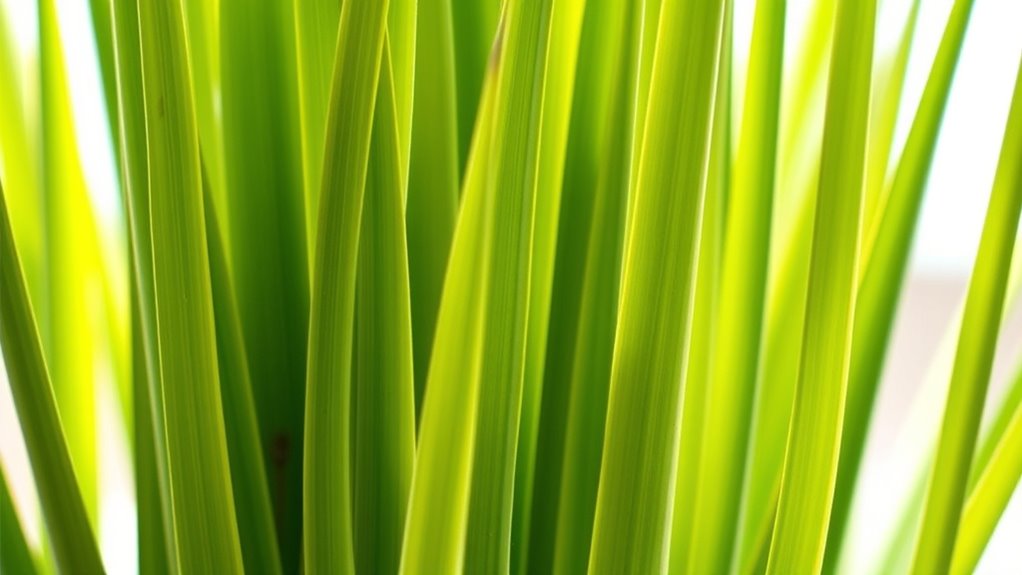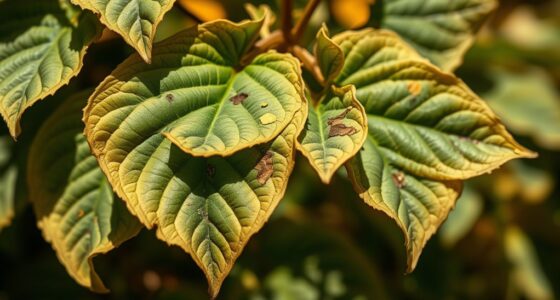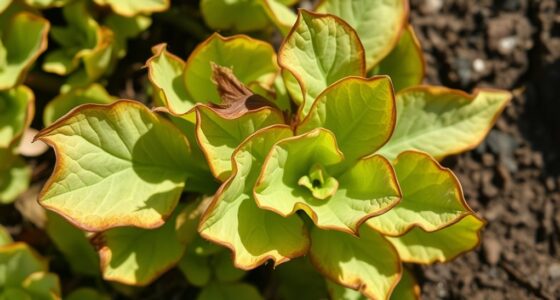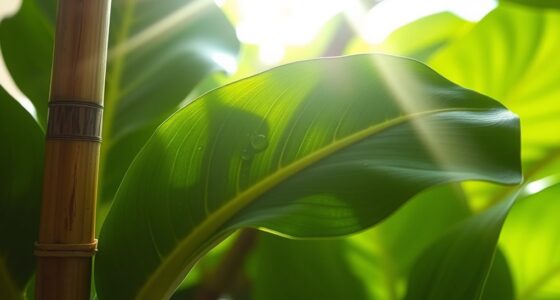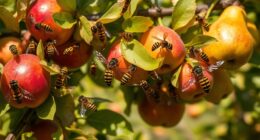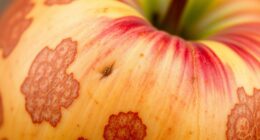If your horsetail plant turns yellow, it could be due to light issues, nutrient deficiencies, or pot problems. Too little light causes weak, pale growth, while too much direct sun can scorch it. Nutrient shortages, especially nitrogen or iron, lead to pale or uneven color. Poor soil drainage or incorrect watering can stress roots. Address these factors, and if problems persist, there’s more to uncover to restore your plant’s health.
Key Takeaways
- Yellowing can result from inadequate light, especially insufficient or improper spectrum, causing stress or poor coloration.
- Nutrient deficiencies like nitrogen, iron, or magnesium often lead to yellowing; soil testing helps identify and correct them.
- Overwatering or poor drainage causes root issues and yellow leaves, while underwatering dries out stems and tips.
- Pest infestations or diseases may worsen yellowing despite proper light and nutrients, requiring targeted treatment.
- Regular monitoring of light, water, and soil health ensures early detection of issues and maintains vibrant, healthy horsetail growth.
Identifying Light Deficiencies and Excesses
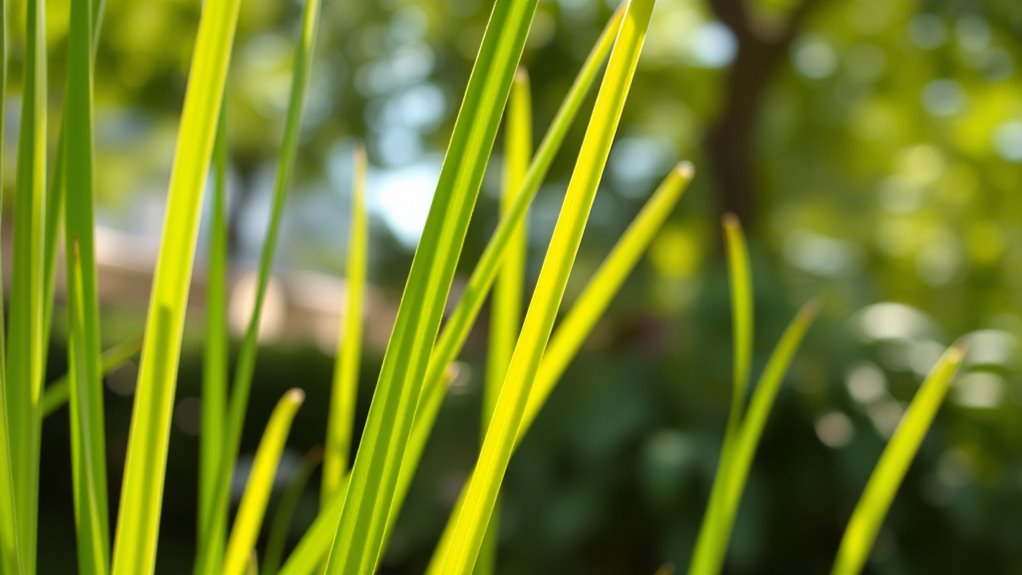
To keep your horsetail plant healthy, recognizing when it’s not getting the right amount of light is essential. Pay attention to its color and growth patterns, as they can signal light deficiencies or excesses. Horsetail plants prefer a full light spectrum, including direct sunlight or bright indirect light. If the plant looks pale or yellowish, it might be receiving too little light, or the light spectrum isn’t suitable. Conversely, too much direct sunlight can scorch the plant’s stems. Adjust your lighting conditions by modifying photoperiods—reducing or increasing light exposure as needed. Ensuring proper photoperiod adjustments helps maintain vibrant green color and healthy growth. Incorporating light management techniques can optimize your plant’s environment for optimal growth. Regular observation will help you fine-tune light levels, preventing stress and promoting prime health. Being aware of light intensity and how it affects plant stress responses is crucial for maintaining a healthy horsetail.
Recognizing Nutrient Imbalances and Shortages

You can spot nutrient deficiencies when your horsetail turns yellow or shows uneven growth. Common gaps include nitrogen, iron, and magnesium, which are essential for healthy foliage. To fix these issues, use targeted fertilization based on the specific nutrient shortfall. Recognizing nutritional needs can help in providing better care and ensuring your horsetail remains vibrant and healthy. Additionally, understanding the optimal growing conditions can prevent further deficiencies and promote robust growth. Incorporating appropriate soil amendments can also support balanced nutrient levels and overall plant vitality.
Signs of Deficiency
When a horsetail plant begins to turn yellow, it often signals a nutrient deficiency that needs immediate attention. One key sign is uneven or dull yellowing of the stems and leaves, indicating you should check your watering frequency—overwatering can cause nutrient leaching, while underwatering stresses the plant. Additionally, soil pH plays a vital role; if it’s too acidic or alkaline, nutrients become unavailable, causing deficiencies. Look for signs like stunted growth or weak stems as clues. You might also notice specific areas turning yellow before others, which can point to imbalanced nutrient uptake. Regularly monitor your watering habits and test soil pH to guarantee your horsetail gets the nutrients it needs. Understanding HEPA filtration can help you ensure your plant’s environment remains free of airborne pollutants that might stress its health. Proper soil management and ensuring balanced nutrient levels are essential for preventing deficiencies and maintaining vibrant growth. Recognizing these signs early helps prevent further deficiencies and keeps your plant healthy.
Common Nutrient Gaps
Recognizing common nutrient gaps in horsetail plants involves observing specific deficiencies that cause characteristic symptoms. Nutrient imbalances often stem from improper soil pH, which affects nutrient availability. For example, a soil pH that’s too high or low can prevent essential nutrients from being absorbed, leading to yellowing leaves. Additionally, pest infestations can interfere with nutrient uptake, exacerbating deficiencies. Here are key nutrient gaps to watch for: 1. Nitrogen deficiency, causing pale or yellowing foliage and stunted growth. 2. Iron deficiency, resulting in chlorosis with yellow leaves and green veins. 3. Magnesium deficiency, leading to yellowing between leaf veins, especially in older fronds. Understanding the evolution of nutrient application techniques can help optimize plant health and prevent these deficiencies. Proper soil testing and nutrient management are essential in addressing these issues effectively. Identifying these signs helps you determine if nutrient imbalances or pest issues are causing the yellowing.
Corrective Fertilization
Identifying nutrient imbalances that cause yellowing leaves allows for targeted corrective fertilization to restore horsetail health. Once you recognize specific deficiencies, you can adjust your fertilizer application accordingly. Use a balanced, water-soluble fertilizer to supply essential nutrients like nitrogen, phosphorus, and potassium. If the soil lacks organic matter, incorporating soil amendments such as compost or organic matter can improve nutrient availability and soil structure. Avoid over-fertilizing, as this can cause more harm than good. Regular, precise fertilizer application ensures the horsetail receives the nutrients it needs without excess. By correcting nutrient shortages with appropriate fertilizer and soil amendments, you promote healthy growth and help the plant regain its vibrant green color.
Assessing Pot and Soil Conditions

To determine if your horsetail plant is struggling, start by examining the pot and soil conditions. Poor soil aeration can lead to root rot and yellowing, so check if the soil feels compacted or waterlogged. Additionally, ensure your container has proper drainage; standing water can suffocate roots and cause stress. Here are key points to assess:
- Soil Aeration: Loosen compacted soil or repot if necessary to improve airflow.
- Container Drainage: Verify that drainage holes aren’t blocked and that excess water escapes easily.
- Soil Moisture: Keep soil consistently moist but not soggy; overwatering can harm the plant.
- Automation and Monitoring: Using automated watering systems can help maintain consistent moisture levels and prevent overwatering issues.
Regularly inspecting these factors helps identify issues early and promotes healthy, green horsetail growth.
Common Environmental Stress Factors
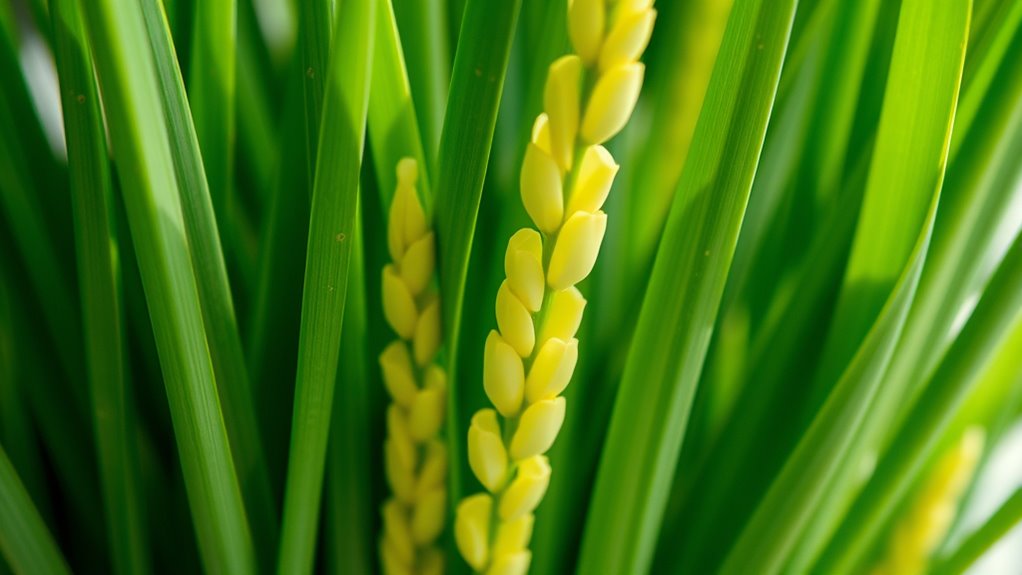
Even if your pot and soil are in good condition, environmental factors outside the container can still stress your horsetail plant. Sudden temperature fluctuations or drafts can cause stress, leading to yellowing or weakened growth. Pest infestations, like spider mites or aphids, may also attack the plant, resulting in visible damage or disease symptoms such as spots or mold. Poor air circulation can increase humidity, promoting disease development and further weakening your horsetail. Additionally, exposure to direct harsh sunlight may scorch the plant, while insufficient light can cause yellowing. Proper ventilation and airflow are essential to prevent such issues. Ensuring adequate light levels helps maintain healthy coloration and growth. Recognizing these environmental stress factors helps you act promptly. Protect your horsetail from extreme conditions, monitor for pests, and ensure proper airflow to keep it healthy and vibrant. Good air circulation also helps disperse excess moisture, reducing the risk of fungal diseases.
Troubleshooting Overwatering and Underwatering
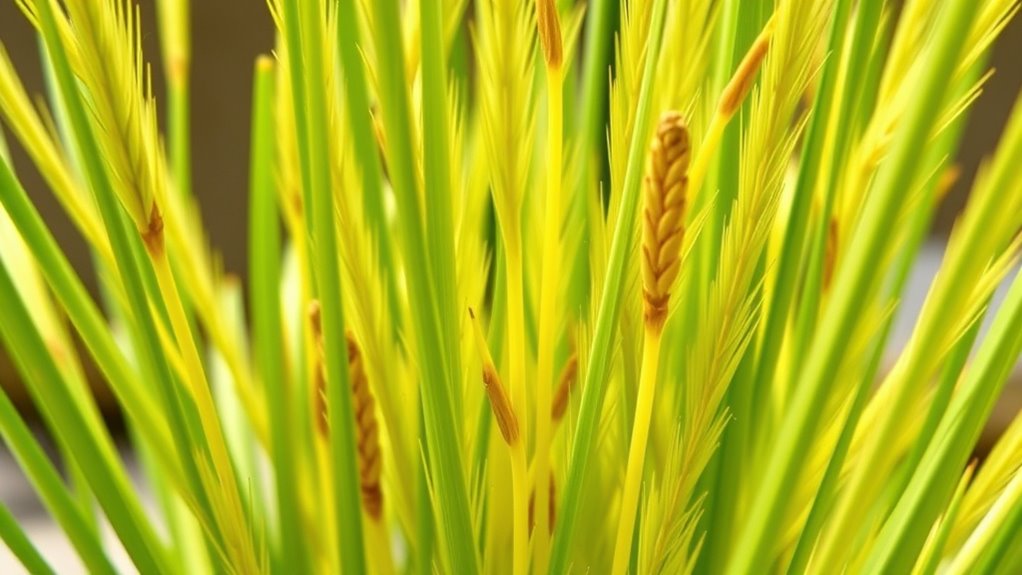
If your horsetail plant’s leaves are turning yellow, it’s important to determine whether you’re overwatering or underwatering. Signs of overwatering include soggy soil and root rot, while underwatering usually shows as dry, brittle stems. Recognizing these symptoms helps you adjust your watering habits effectively. Additionally, digital literacy programs can help you better understand plant care through online resources and community support. Understanding watering techniques can further refine your approach and promote healthier plant growth. Implementing proper watering schedules can prevent issues caused by inconsistent watering habits.
Identifying Overwatering Signs
Overwatering is a common mistake that can cause your horsetail plant to turn yellow, so it’s important to recognize the signs early. One key indicator is overly moist soil that doesn’t dry out between waterings, often due to excessive watering frequency. Additionally, poor soil drainage causes water to pool around the roots, leading to root rot and yellowing leaves. You should also look for soft, mushy stems or leaves that feel limp and waterlogged. To identify overwatering signs clearly, monitor the soil for persistent dampness and ensure proper drainage. Proper soil conditions and drainage are crucial for preventing overwatering issues and keeping your horsetail healthy. Using appropriate soil with good aeration and drainage capacity can greatly reduce water retention and improve plant health.
Recognizing Underwatering Symptoms
Recognizing underwatering symptoms is essential to maintaining a healthy horsetail plant, especially since signs can easily be mistaken for overwatering issues. When your plant is underwatered, it experiences watering stress, leading to drooping or browning tips. The soil may feel dry to the touch, and the plant’s overall vigor diminishes. You might notice root damage if the plant has been deprived of moisture for too long, weakening its ability to absorb nutrients and water. To confirm underwatering, check the soil moisture regularly—if it’s dry several inches down, it’s time to water thoroughly. Addressing watering stress promptly helps prevent further root damage and keeps your horsetail healthy and vibrant. Proper watering ensures roots stay strong and the plant remains lush. Recognizing water stress signs early allows for timely intervention, promoting healthier growth and resilience.
When to Seek Professional Advice

You should consider consulting a professional when your horsetail plant’s yellowing persists despite adjusting watering practices and guaranteeing proper drainage. A professional diagnosis can identify underlying issues beyond simple care adjustments. Seek expert consultation if you notice signs such as:
- Unusual spots or lesions on the plant, indicating potential disease.
- Rapid or widespread yellowing that doesn’t improve with basic care.
- Symptoms that worsen despite addressing light, nutrients, and watering routines.
In these cases, a specialist can provide targeted solutions and accurate diagnoses, helping you avoid further damage. Recognizing when professional advice is needed ensures your horsetail receives appropriate care. Don’t hesitate to consult a plant expert to safeguard your plant’s health and vigor.
Frequently Asked Questions
Can Pests Cause Horsetail Plant Leaves to Turn Yellow?
Yes, pests can cause horsetail plant leaves to turn yellow. Pest damage from insect infestation often weakens the plant’s tissues, leading to yellowing leaves. When insects feed on the plant, they disrupt nutrient flow, causing stress and discoloration. If you notice yellowing leaves, check for signs of pests like tiny insects or webbing. Addressing the pest problem promptly can help restore your horsetail’s health and prevent further yellowing.
How Does Soil Ph Affect Horsetail Plant Health?
They say “a stitch in time saves nine,” so understanding soil pH is key. Soil acidity and pH balance directly impact horsetail plant health. If the soil’s pH is too high or low, it can cause nutrient deficiencies, leading to yellowing leaves. Maintaining the right soil pH ensures your horsetail gets the nutrients it needs, keeping it vibrant and healthy. Test your soil regularly for suitable pH levels.
What Are Natural Remedies for Yellowing Horsetail Leaves?
To treat yellowing horsetail leaves naturally, start with foliage treatment by gently rinsing the leaves to remove dust. You can also apply compost around the base to boost nutrients and improve soil health. Guarantee the plant gets adequate light and water, and consider using organic liquid fertilizers as needed. Regularly monitor your horsetail and adjust care to keep it healthy, vibrant, and free from yellowing.
Does Pruning Help Revive a Yellowing Horsetail Plant?
Think of pruning as giving your horsetail plant a fresh start, like clearing away dead branches to let new growth thrive. Pruning benefits include removing yellowed or damaged stems, which encourages healthy, vibrant growth. It’s a key revive technique that can restore your plant’s energy. If you prune correctly, you’ll likely see your horsetail bounce back stronger, happier, and greener, proving that sometimes, a simple cut can make all the difference.
How Long Does It Take for a Stressed Horsetail to Recover?
When your horsetail plant is stressed, recovery time varies based on the severity of the issues. Usually, it takes a few weeks to a month for noticeable improvement if you address underlying problems like light, nutrients, or pot size. During this period, you should adjust care practices, guarantee proper watering, and offer ideal light. Patience is key, as consistent care helps your plant bounce back from stress effectively.
Conclusion
By understanding these key factors, you can uncover what’s causing your horsetail plant to turn yellow. But beware—sometimes the signs point to more than just light, nutrients, or pot issues. Could hidden pests or unseen root problems be at play? Stay observant and trust your instincts. The solution might be closer than you think, but the true cause remains a mystery until you dig deeper. Are you ready to uncover what’s really behind the color change?
